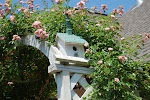Completed French Seam on Wrong Side.
A French seam is made by sewing the wrong sides together, trimming that first seam allowance to just under 1/8" and stitching again with right sides together. You can use this method no matter what your pattern seam allowance is. Just remember that the final stitched seam will be 1/8", so your first seam will take up the rest of the seam allowance. A little math is required. For instance, if your seam allowance is 1/2", your first stitching will be 3/8 away from the fabric edge. Trim to just barely under 1/8" and stitch the final seam 1/8". 3/8" plus 1/8" equals 1/2". For this lesson, the total seam allowance will be 3/8" because most of the seams in my Old Fashioned Baby Patterns are 3/8". So...the first stitching (wrong sides together) will be 1/4" , trim to just barely under 1/8" , turn right sides together and stitch the final seam 1/8". Do not make the mistake of trimming the seam allowance too close to the stitching line. If you do, your seam will unravel with washing. While there are many "tricks" to making French Seams, I use the standard method, which works beautifully.Step 1. Trim off fuzzies from fabric to be stitched.

Use fine silk pins so you don't damage fine fabric.
Step 2. Pin wrong sides together.
Sew wrong sides together, 1/4" from edge of fabric. A Straight Stitch foot is invaluable for stitching French Seams. The Pfaff Straight Stitch Quilting Foot is shown on the right. This foot allows you to line up the edge of the fabric with the edge of the foot for perfect 1/4" seams. It also gives you more control of the fabric as you stitch these tiny seams. Wonderful Machine Foot. Check with your Sewing Machine Dealer for one that fits your machine.
Step 3. Press, trim and turn. Press the seam you have just stitched to meld the stitches.
Trim the seam allowance to just barely less than 1/8".

Open the fabric and press the seam allowance to one side (usually the back of the garment). Notice how I am pulling on the fabric slightly as I press. This helps to open up the seam completely as I press.

Press the seam line again from the front to ensure the seam is pressed completely open.
Fold fabric right sides together and pin.
Always hold the threads when you begin to sew any seam!
Step 4. Sew 1/8" away from the edge with right sides together.
The picture on the left shows the wrong side of the fabric with the seam partially sewn. The picture on the right shows the right side of the fabric with the seam partially sewn. You can see the first seam allowance that is being enclosed by the second stitching. Neat!
French Seams are a sign of quality on fine Baby Clothes, Children's garments and Womens fine undies and nighties!































































































4 comments:
Great little tutorial! French seams are now second nature to me. I've even been know to make them on puffed sleeves - although this is a bit difficult. I have learned to use a lightning stitch on heavier fabrics, but not on the fabrics you are showing here.
Great tutorial! Although Pfaff no longer makes the Straight Stitch Quilting Foot you show, I was able to find it on eBay from ngosew for $7.95 and free shipping. Thought maybe other viewers might be looking for it also. I already had the straight stich 1/4" foot with the edge, but I wanted on with the edge guide as it not good for all materials.
Hi! I've been reading your web site for a while now and finally got the bravery to go ahead and give you a shout out from Dallas Texas! Just wanted to say keep up the excellent job!kids online clothing store australia
Excellent and thoughtful end to your blogging I followed your blog with great interest. Thanks for all of the information and entertainment!
Post a Comment